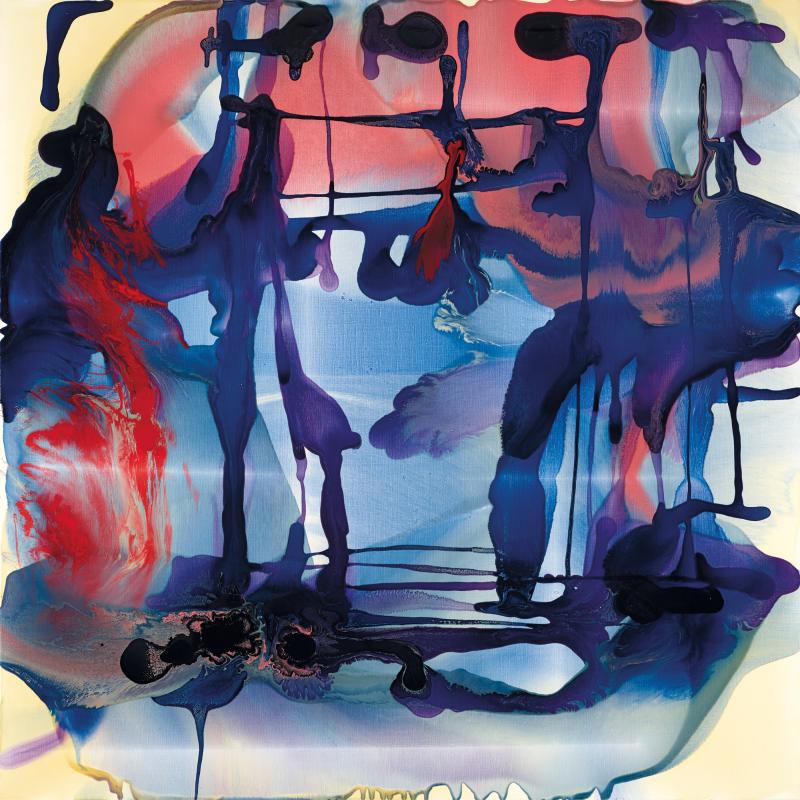DALE FRANK born 1959
Transient Ischemic Attack Painting London 3 (TIAPL3): Sheep get static cling when they rub together 2005
Estimate: $40000 - 60000
Sold For:
$40000 hammer
$49091 inc. buyer's premium
Description
DALE FRANK born 1959
Transient Ischemic Attack Painting London 3 (TIAPL3): Sheep get static cling when they rub together 2005
varnish on linen
200.0 x 200.0 cm
twice signed and dated verso: Dale Frank/ 2005/ Dale Frank 2005
Provenance:
Anna Schwartz Gallery, Melbourne, 2010 (label attached verso)
Private collection, Melbourne
Estimate: $40000 - 60000
Result Hammer: $40000
Dale Frank’s work cannot be placed into a single category; it is as much performance as it is painting. His early practice was dominated by performance-based work; a notable example taking place in Italy in the late 1970s, where viewers entering a gallery were presented with Frank’s legs and leather shoes dangling from a hatch in the ceiling. Twenty years later, Frank created a disco for the opening night of his 1995 exhibition Dale, I’m only dancing, at Rosyln Oxley9 Gallery in Sydney, complete with lights, a fog machine, and a DJ. What connects these earlier works to Frank’s more recent examples is the continuous pursuit to explore the exchange between the artist’s performance and the participation of the viewer.
Frank’s work is a staged clash between his own practice and accepted artistic movements. He chooses not to conform strictly to one artistic aspect, constantly breaking the rules and perhaps hinting at his own subversion to 20th century art history.1 In an interview that coincided with Frank’s Museum of Contemporary Art exhibition Dale Frank: Ecstasy 2000, that celebrated 20 years of painting, Frank staunchly refutes the idea that his work pays homage to art of the past, suggesting the ability to find familiar formal elements in the work is purely cosmetic.2 Instead Frank embodies a sense of stylistic freedom, continuously exploring the nature of art itself and its multi-layered relationship to reality, to ‘real’ objects and situations, and the time in which it was made.3
The choice of medium Frank uses ignites a performance that allows for a spirit of experimentation. The present work uses a combination of powdered and liquid pigments encased in varnish, that are individually mixed before being strewn across a flat canvas. This is where the performance starts to take shape. Frank pulls at the pigments from each side of the canvas, dropping them from a height, dragging them across the surface and physically lifting the support to initiate movement. Different paint temperatures and time ratios effect the finished work, providing an overarching structure. The application of the varnish appears erratic, unplanned, and fluid, causing the paintings to be somewhat void of the artist and to exist by themselves as their own living entities.
The present work emits elegance and the joy of investigation. Layers of royal blue and monarch purple glisten over a vivid wash of lollypop pink that encases a vibrant cornflower blue pool in the centre of the composition. The direction of the drips and glossy puddles of varnish momentarily disarm the viewer as they try to make sense of the point of gravity within the work. Too much colour and texture suddenly coalesce in a sophisticated balance; a recognisable gesture begins to form and is then on the move again. This is the pleasure of Frank’s work; the internal dynamism raises questions, but rewards sustained and repeated engagement.
The intuitive response to Frank’s work is further complicated by his choice of titles. Often lengthy, meandering and seemingly unrelated to the work at hand, they allow him to rebuke even the traditional constraints of art whilst adding an additional performative layer. Frank has commented on his titles saying, ‘they are parallel to the paintings; they have the same connection to society as the paintings do… people read into them and induce associations that I could not dream of. You cannot read into them; it is a free-form situation just like the paintings.’4
Interactive performance remains at the forefront of Frank’s oeuvre. The present work is an important example of Franks expansive growth that entices the viewer, allowing them to build their own relationship to the work.
Footnotes
1.Magon, J., Dale Frank, Craftsman House, Sydney, 1992, p.45
2.Cramer, S., Dale Frank: Ecstasy (Twenty Years of Painting), Museum of Contemporary Art, Sydney, 2000, p.14
3.Ibid., p.3
4.Cramer, S., op. cit., p.14
Clementine Retallack
Specialists
-

Cameron Menzies, Chairman & Head of Private Sales
cmenzies@menziesartbrands.com
+61 (0) 466 636 142 -

Asta Cameron, Art Specialist
acameron@menziesartbrands.com
+61 (0) 400 914 088 -

Clementine Retallack, Front of House Manager & Associate Art Specialist
cretallack@menziesartbrands.com
+61 (0) 478 493 026
Location
Sale & Exhibition Details
-
Auction
27 March 2024
6:30PM AEDT
1 Darling Street
SOUTH YARRA VIC 3141
artauctions@menziesartbrands.com -
Exhibition
-
Sydney
14-17 March 2024
10:00AM to 5:00PM AEDT
12 Todman Avenue
KENSINGTON NSW 2033
art@menziesartbrands.com -
Melbourne
21-26 March 2024
10:00AM to 5:00PM AEDT
1 Darling Street
SOUTH YARRA VIC 3141
artauctions@menziesartbrands.com
-


